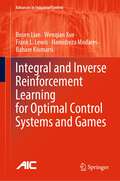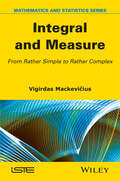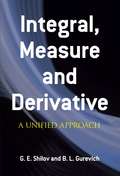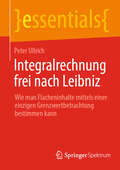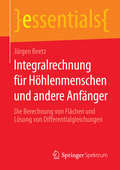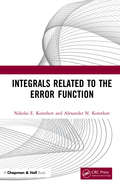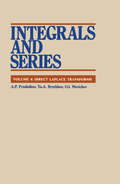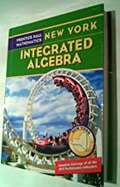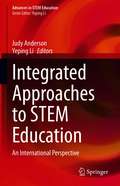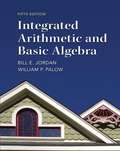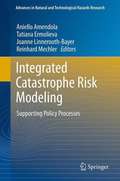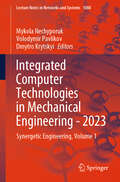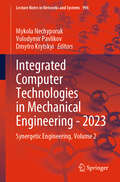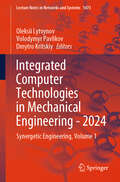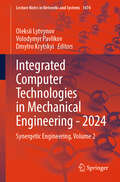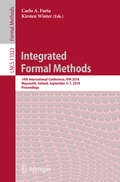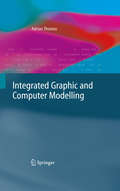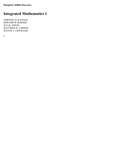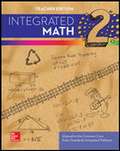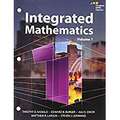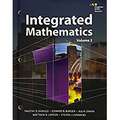- Table View
- List View
Integral and Inverse Reinforcement Learning for Optimal Control Systems and Games (Advances in Industrial Control)
by Frank L. Lewis Bosen Lian Wenqian Xue Hamidreza Modares Bahare KiumarsiIntegral and Inverse Reinforcement Learning for Optimal Control Systems and Games develops its specific learning techniques, motivated by application to autonomous driving and microgrid systems, with breadth and depth: integral reinforcement learning (RL) achieves model-free control without system estimation compared with system identification methods and their inevitable estimation errors; novel inverse RL methods fill a gap that will help them to attract readers interested in finding data-driven model-free solutions for inverse optimization and optimal control, imitation learning and autonomous driving among other areas. Graduate students will find that this book offers a thorough introduction to integral and inverse RL for feedback control related to optimal regulation and tracking, disturbance rejection, and multiplayer and multiagent systems. For researchers, it provides a combination of theoretical analysis, rigorous algorithms, and a wide-ranging selection of examples. The book equips practitioners working in various domains – aircraft, robotics, power systems, and communication networks among them – with theoretical insights valuable in tackling the real-world challenges they face.
Integral and Measure: From Rather Simple to Rather Complex
by Vigirdas MackeviciusThis book is devoted to integration, one of the two main operations in calculus. In Part 1, the definition of the integral of a one-variable function is different (not essentially, but rather methodically) from traditional definitions of Riemann or Lebesgue integrals. Such an approach allows us, on the one hand, to quickly develop the practical skills of integration as well as, on the other hand, in Part 2, to pass naturally to the more general Lebesgue integral. Based on the latter, in Part 2, the author develops a theory of integration for functions of several variables. In Part 3, within the same methodological scheme, the author presents the elements of theory of integration in an abstract space equipped with a measure; we cannot do without this in functional analysis, probability theory, etc. The majority of chapters are complemented with problems, mostly of the theoretical type. The book is mainly devoted to students of mathematics and related specialities. However, Part 1 can be successfully used by any student as a simple introduction to integration calculus.
Integral, Measure and Derivative: A Unified Approach
by G. E. Shilov B. L. GurevichThis graduate-level textbook and monograph defines the functions of a real variable through consistent use of the Daniell scheme, offering a rare and useful alternative to customary approaches. The treatment can be understood by any reader with a solid background in advanced calculus, and it features many problems with hints and answers. "The exposition is fresh and sophisticated," declared Sci-Tech Book News, "and will engage the interest of accomplished mathematicians." Part one is devoted to the integral, moving from the Reimann integral and step functions to a general theory, and obtaining the "classical" Lebesgue integral in n space. Part two constructs the Lebesgue-Stieltjes integral through the Daniell scheme using the Reimann-Stieltjes integral as the elementary integral. Part three develops theory of measure with the general Daniell scheme, and the final part is devoted to the theory of the derivative.
Integralrechnung frei nach Leibniz: Wie man Flächeninhalte mittels einer einzigen Grenzwertbetrachtung bestimmen kann (essentials)
by Peter UllrichIn einem Manuskript aus dem Jahre 1676 behandelt Gottfried Wilhelm Leibniz (1646–1716) die Integration monotoner Funktionen. Hieraus lässt sich eine Integrationstheorie entwickeln, mittels derer man alle in der Schule verwendeten Basisfunktionen integrieren und allgemeine Integrationsregeln herleiten kann. Im Gegensatz zu dem üblichen formalen Zugang benötigt diese Theorie nur einen propädeutischen Grenzwertbegriff, wie er in den KMK-Bildungsstandards gefordert wird; letztlich reicht eine einzige Grenzwertbetrachtung aus. Zudem wird die Integralrechnung nicht auf eine Umkehrung der Differentialrechnung reduziert.
Integralrechnung für Höhlenmenschen und andere Anfänger: Die Berechnung von Flächen und Lösung von Differentialgleichungen (essentials)
by Jürgen BeetzJürgen Beetz führt zuerst in den Ursprung der erdachten Geschichten der Mathematik aus der Steinzeit ein. Im Anschluss daran stellt er die zentrale Fragestellung der ,,Infinitesimalrechnung" anhand eines einfachen Beispiels dar. Dann erläutert der Autor die Grundproblematik des Integrierens: die Fläche zwischen einer beliebigen Stelle einer Funktion y=f(x) und der x-Achse festzustellen. Es gibt einige bekannte Sätze, z. B. den Mittelwertsatz und den Hauptsatz der Integralrechnung. Hauptanwendungsgebiet der Integralrechnung ist das Lösen von Differentialgleichungen: Gleichungen, die Funktionen und ihre Ableitungen nebeneinander enthalten.
Integrals Related to the Error Function
by Nikolai E. Korotkov Alexander N. KorotkovIntegrals Related to the Error Function presents a table of integrals related to the error function, including indefinite and improper definite integrals. Most of the formulas in this book have not been presented in other tables of integrals or have been presented only for some special cases of parameters or for integration only along the real axis of the complex plane. Many of the integrals presented here cannot be obtained using a computer (except via an approximate numerical integration). Additionally, for improper integrals, this book emphasizes the necessary and sufficient conditions for the validity of the presented formulas, including trajectory for going to infinity on the complex plane; such conditions are usually not given in computer-assisted analytical integration and often not presented in the previously published tables of integrals. Features The first book in English language to present a comprehensive collection of integrals related to the error function Useful for researchers whose work involves the error function (e.g., via probability integrals in communication theory). Additionally, it can also be used by broader audience.
Integrals and Series: Direct Laplace Transforms
by A.B PrudnikovVolumes 4 and 5 of the extensive series Integrals and Series are devoted to tables of LaplaceTransforms. In these companion volumes the authors have collected data scatteredthroughout the literature, and have augmented this material with many unpublished resultsobtained in their own research.Volume 4 contains tables of direct Laplace transforms, a number of which are expressed interms of the Meijer G-function. When combined with the table of special cases, theseformulas can be used to obtain Laplace transforms of numerous elementary and specialfunctions of mathematical physics.Volume 5 offers tables of inversion formulas for the Laplace transformation and includestables of factorization and inversion of various integral transforms.
Integrated Approaches to STEM Education: An International Perspective (Advances in STEM Education)
by Yeping Li Judy AndersonThis book provides a platform for international scholars to share evidence for effective practices in integrated STEM education and contributes to the theoretical and practical knowledge gained from the diversity of approaches. Many publications on STEM education focus on one or two of the separate STEM disciplines without considering the potential for delivering STEM curriculum as an integrated approach.This publication analyzes the efficacy of an integrated STEM curriculum and instruction, providing evidence to examine and support various integrations. The volume focuses on the problems seen by academics working in the fields of science, technology, engineering and mathematics (STEM) and provides valuable, high quality research outcomes and a set of valued practices which have demonstrated their use and viability to improve the quality of integrated STEM education.
Integrated Arithmetic and Basic Algebra (5th Edition)
by Bill E. Jordan William P. PalowIntegrated Arithmetic and Basic Algebra, Fifth Edition, integrates arithmetic and algebra to allow students to see the big picture of math. Rather than separating these two subjects, this text helps students recognize algebra as a natural extension of arithmetic. As a result, students see how concepts are interrelated and are better prepared for future courses.
Integrated Catastrophe Risk Modeling: Supporting Policy Processes
by Tatiana Ermolieva Aniello Amendola Reinhard Mechler Joanne Linnerooth-BayerEfficient and equitable policies for managing disaster risks and adapting to global environmental change are critically dependent on development of robust options supported by integrated modeling. The book is based on research and state-of-the art models developed at IIASA (International Institute for Applied Systems Analysis) and within its cooperation network. It addresses the methodological complexities of assessing disaster risks, which call for stochastic simulation, optimization methods and economic modeling. Furthermore, it describes policy frameworks for integrated disaster risk management, including stakeholder participation facilitated by user-interactive decision-support tools. Applications and results are presented for a number of case studies at different problem scales and in different socio-economic contexts, and their implications for loss sharing policies and economic development are discussed. Among others, the book presents studies for insurance policies for earthquakes in the Tuscany region in Italy and flood risk in the Tisza river basin in Hungary. Further, it investigates the economic impact of natural disasters on development and possible financial coping strategies; and applications are shown for selected South Asian countries. The book is addressed both to researchers and to organizations involved with catastrophe risk management and risk mitigation policies.
Integrated Catastrophe Risk Modeling: Supporting Policy Processes (Advances in Natural and Technological Hazards Research #32)
by Tatiana Ermolieva Aniello Amendola Reinhard Mechler Joanne Linnerooth-BayerEfficient and equitable policies for managing disaster risks and adapting to global environmental change are critically dependent on development of robust options supported by integrated modeling. The book is based on research and state-of-the art models developed at IIASA (International Institute for Applied Systems Analysis) and within its cooperation network. It addresses the methodological complexities of assessing disaster risks, which call for stochastic simulation, optimization methods and economic modeling. Furthermore, it describes policy frameworks for integrated disaster risk management, including stakeholder participation facilitated by user-interactive decision-support tools. Applications and results are presented for a number of case studies at different problem scales and in different socio-economic contexts, and their implications for loss sharing policies and economic development are discussed. Among others, the book presents studies for insurance policies for earthquakes in the Tuscany region in Italy and flood risk in the Tisza river basin in Hungary. Further, it investigates the economic impact of natural disasters on development and possible financial coping strategies; and applications are shown for selected South Asian countries. The book is addressed both to researchers and to organizations involved with catastrophe risk management and risk mitigation policies.
Integrated Computer Technologies in Mechanical Engineering - 2023: Synergetic Engineering, Volume 1 (Lecture Notes in Networks and Systems #1008)
by Mykola Nechyporuk Dmytro Krytskyi Volodymir PavlikovThe International Scientific and Technical Conference “Integrated Computer Technologies in Mechanical Engineering” – Synergetic Engineering (ICTM) was established by National Aerospace University “Kharkiv Aviation Institute”. The Conference ICTM’2023 was held in Kharkiv, Ukraine, during December, 2023. During this conference, technical exchanges between the research community were carried out in the forms of keynote speeches, panel discussions, as well as special session. In addition, participants were treated to a series of receptions, which forge collaborations among fellow researchers. ICTM’2023 received 202 papers submissions from different countries. All of these offer us plenty of valuable information and would be of great benefit to the experience exchange among scientists in modeling and simulation. The organizers of ICTM’2023 made great efforts to ensure the success of this conference. We hereby would like to thank all the members of ICTM’2023 Advisory Committee for their guidance and advice, the members of program committee and organizing committee, and the referees for their effort in reviewing and soliciting the papers, and all authors for their contribution to the formation of a common intellectual environment for solving relevant scientific problems. Also, we grateful to Springer - Janusz Kacprzyk and Thomas Ditzinger as the editor responsible for the series “Lecture Notes in Networks and Systems” for their great support in publishing these selected papers.
Integrated Computer Technologies in Mechanical Engineering - 2023: Synergetic Engineering, Volume 2 (Lecture Notes in Networks and Systems #996)
by Mykola Nechyporuk Dmytro Krytskyi Volodymir PavlikovThe International Scientific and Technical Conference “Integrated Computer Technologies in Mechanical Engineering” – Synergetic Engineering (ICTM) was established by National Aerospace University “Kharkiv Aviation Institute”. The Conference ICTM’2023 was held in Kharkiv, Ukraine, during December, 2023. During this conference, technical exchanges between the research community were carried out in the forms of keynote speeches, panel discussions, as well as special session. In addition, participants were treated to a series of receptions, which forge collaborations among fellow researchers. ICTM’2023 received 202 papers submissions from different countries. All of these offer us plenty of valuable information and would be of great benefit to the experience exchange among scientists in modeling and simulation. The organizers of ICTM’2023 made great efforts to ensure the success of this conference. We hereby would like to thank all the members of ICTM’2023 Advisory Committee for their guidance and advice, the members of program committee and organizing committee, and the referees for their effort in reviewing and soliciting the papers, and all authors for their contribution to the formation of a common intellectual environment for solving relevant scientific problems. Also, we grateful to Springer - Janusz Kacprzyk and Thomas Ditzinger as the editor responsible for the series “Lecture Notes in Networks and Systems” for their great support in publishing these selected papers.
Integrated Computer Technologies in Mechanical Engineering - 2024: Synergetic Engineering, Volume 1 (Lecture Notes in Networks and Systems #1473)
by Volodymyr Pavlikov Dmytro Krytskyi Oleksii LytvynovThis book covers areas such as information technology in engine design and production; information technology in the creation of rocket and space systems; aerospace engineering; transport systems and logistics; big data and data science; nanomodeling; artificial intelligence and intelligent systems; networks and communications; cyber-physical systems and IoE; as well as software engineering and IT infrastructure.The materials were tested during the International Scientific and Technical Conference "Integrated Computer Technologies in Mechanical Engineering"—Synergetic Engineering (ICTM) was established by the National Aerospace University "Kharkiv Aviation Institute".The ICTM'2024 conference was held in Kharkiv, Ukraine, in December 2024. During this conference, technical exchange between the scientific community was carried out in the form of keynote speeches, panel discussions and a special session. More than 140 papers from different countries were received at ICTM'2024.The book offers us a lot of valuable information and is very useful for the exchange of experience between scientists in the field of modeling and simulation.ICTM was created to bring together outstanding researchers and practitioners in the field of information technology in the design and manufacture of engines; the creation of rocket and space systems, aerospace engineering from all over the world to exchange experiences and expertise.
Integrated Computer Technologies in Mechanical Engineering - 2024: Synergetic Engineering, Volume 2 (Lecture Notes in Networks and Systems #1474)
by Volodymyr Pavlikov Dmytro Krytskyi Oleksii LytvynovThis book covers areas such as information technology in engine design and production; information technology in the creation of rocket and space systems; aerospace engineering; transport systems and logistics; big data and data science; nanomodeling; artificial intelligence and intelligent systems; networks and communications; cyber-physical systems and IoE; as well as software engineering and IT infrastructure.The materials were tested during the International Scientific and Technical Conference "Integrated Computer Technologies in Mechanical Engineering"—Synergetic Engineering (ICTM) was established by the National Aerospace University "Kharkiv Aviation Institute".The ICTM'2024 conference was held in Kharkiv, Ukraine, in December 2024. During this conference, technical exchange between the scientific community was carried out in the form of keynote speeches, panel discussions and a special session. More than 140 papers from different countries were received at ICTM'2024.The book offers us a lot of valuable information and is very useful for the exchange of experience between scientists in the field of modeling and simulation.ICTM was created to bring together outstanding researchers and practitioners in the field of information technology in the design and manufacture of engines; the creation of rocket and space systems, aerospace engineering from all over the world to exchange experiences and expertise.
Integrated Formal Methods: 14th International Conference, IFM 2018, Maynooth, Ireland, September 5-7, 2018, Proceedings (Lecture Notes in Computer Science #11023)
by Carlo A. Furia Kirsten WinterThis book constitutes the refereed proceedings of the 14th International Conference on Integrated Formal Methods, IFM 2018, held in Maynooth, Ireland, in September 2018.The 17 full papers and 5 short papers presented together with 3 invited talks were carefully reviewed and selected from 60 submissions. The conference covers a broad spectrum of topics: from language design, to verification and analysis techniques, to supporting tools and their integration into software engineering practice.
Integrated Graphic and Computer Modelling
by Adrian ThomasComputer languages and computer graphics have become the primary modes of human-computer interaction. This book provides a basic introduction to "Real and Virtual Environment" computer modelling. Graphics models are used to illustrate both the way computer languages are processed and also used to create computer models of graphic displays. Computer languages have been bootstrapped from machine code, to high-level languages such as Java, to animation scripting languages. Integrating graphic and computer models takes this support for programming, design and simulation work, one step further, allowing interactive computer graphic displays to be used to construct computer models of both real and virtual environment systems. The Java language is used to implement basic algorithms for language translation, and to generate graphic displays. It is also used to simulate the behaviour of a computer system, to explore the way programming and design-simulation environments can be put together.
Integrated Management of Water Resources in India: Optimizing for Sustainability and Planning (Water Science and Technology Library #129)
by Vijay P. Singh Akhilesh Kumar Yadav Kanchan YadavThis book tackles the complexities of water management in India. Using computational tools, it provides comprehensive information on water availability, demand, climate change, integrated management, and governance. A must-read for researchers, policymakers, and water managers. The book is structured to provide a holistic understanding of water resources in India and the need for an integrated approach to their management. It explores various aspects of water management, including data collection and analysis, water allocation and planning, water quality management, and the intricate interdependencies within the water-energy-food nexus. One of the key focuses of this book is the application of computational approaches in the management of water resources. We explore the use of advanced modeling, simulation, and optimization techniques to facilitate decision making, assess water availability, and predict future scenarios. By employing computational tools, our goal is to bridge the gap between theoretical concepts and practical implementation, empowering water managers, policymakers, researchers, and other stakeholders to make informed and effective decisions. Throughout the book, we present case studies highlighting the application of computational approaches in diverse water management scenarios in India. These case studies offer valuable information on real-world challenges and demonstrate the potential of computational techniques to address complex water resources problems. We also explore the importance of stakeholder engagement, participatory approaches, and collaborative governance models, recognizing the importance of inclusive decision-making processes and local knowledge in achieving sustainable water management. The book is expected to serve as a valuable resource for students, researchers, professionals, and policymakers involved in water resource management in India. We aim to contribute to the ongoing efforts to ensure the availability of clean and adequate water resources for present and future generations.
Integrated Math 1: Student Edition 2015 (HMH Integrated Math 1)
by Timothy D. Kanold Edward B. Burger Juli K. Dixon Steven J. Leinwand Matthew R. LarsonIntegrated Mathematics 1, Volume 1
by Timothy D. Kanold Edward B. Burger Juli K. DixonNIMAC-sourced textbook
Integrated Mathematics 1, Volume 2
by Timothy D. Kanold Edward B. Burger Juli K. DixonNIMAC-sourced textbook
Integrated Mathematics 2, Volume 1
by Timothy D. Kanold Edward B. Burger Juli K. DixonNIMAC-sourced textbook
